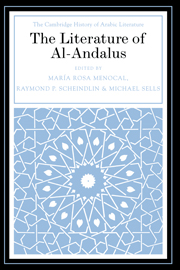Book contents
- Frontmatter
- 1 Visions of al-Andalus
- PART I THE SHAPES OF CULTURE
- PART II THE SHAPES OF LITERATURE
- PART III ANDALUSIANS
- 10 Ibn Ḥazm
- 11 Moses Ibn Ezra
- 12 Judah Halevi
- 13 Petrus Alfonsi
- 14 Ibn Quzmān
- 15 Ibn Zaydūn
- 16 Ibn Ṭufayl
- 17 Ibn ʿArabī
- 18 Ramon Llull
- 19 Ibn al-Khaṭīb
- PART IV TO SICILY
- PART V MARRIAGES AND EXILES
- PART VI TO AL-ANDALUS, WOULD SHE RETURN THE GREETING
- Index
- References
17 - Ibn ʿArabī
from PART III - ANDALUSIANS
Published online by Cambridge University Press: 28 May 2012
- Frontmatter
- 1 Visions of al-Andalus
- PART I THE SHAPES OF CULTURE
- PART II THE SHAPES OF LITERATURE
- PART III ANDALUSIANS
- 10 Ibn Ḥazm
- 11 Moses Ibn Ezra
- 12 Judah Halevi
- 13 Petrus Alfonsi
- 14 Ibn Quzmān
- 15 Ibn Zaydūn
- 16 Ibn Ṭufayl
- 17 Ibn ʿArabī
- 18 Ramon Llull
- 19 Ibn al-Khaṭīb
- PART IV TO SICILY
- PART V MARRIAGES AND EXILES
- PART VI TO AL-ANDALUS, WOULD SHE RETURN THE GREETING
- Index
- References
Summary
Muḥammad ibn ʿAlī ibn Muḥ ammad ibn al-ʿArabī, as he styled himself in his writings, or Muḥyī l-Dīn ibn ʿArabī, as he was known to Eastern Muslims, was born in Murcia in 560/1165, at the beginning of the Almohad reign. Following the death of the local ruler Ibn Mardanīsh, Ibn ʿArabī’s father, a high-ranking Arab official at the Murcian court, moved to Seville to take a post in the Almohad sultan’s administration. There, in the capital of the Almohad state, the young Ibn ʿArabī was schooled in the traditional Islamic sciences including the Qurʾan and Qurʾanic exegesis, hadith, jurisprudence, adab, and kalam. He studied with the best Andalusi ulama of his epoch and quickly mastered all the major fields of Arabo-Islamic knowledge.
Little is known about that early period, which Ibn ʿArabī subsequently dismissed as a mere prelude to his all-important mystical life (Austin, Sufis 24; Addas, Ibn ʿArabī 45–51). There is some evidence that he was employed as a secretary at the chancery of the governor of Seville, although the exact circumstances of his worldly career cannot be ascertained. In Ibn ʿArabī’s own words, he led the carefree life typical of wealthy young men of noble Arab stock (Addas, Ibn ʿArabī 55–56).
- Type
- Chapter
- Information
- The Literature of Al-Andalus , pp. 331 - 344Publisher: Cambridge University PressPrint publication year: 2000
References
- 4
- Cited by



